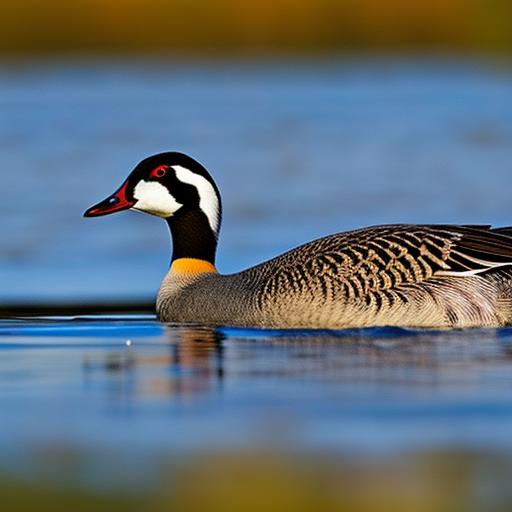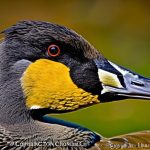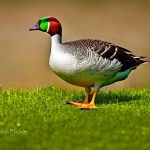Canadian geese can be a nuisance for property owners, causing damage to lawns, gardens, and even posing health risks with their droppings. Finding effective and non-harmful solutions to manage these geese is crucial. It is important to address this issue in a humane and environmentally friendly way, as these birds are protected under the Migratory Bird Treaty Act. In this article, we will explore various methods and strategies for deterring Canadian geese from your property without causing harm to them or the environment.
Key Takeaways
- Canadian geese are attracted to open spaces near water and grassy areas.
- Non-harmful deterrents such as decoys, lasers, and dogs can be effective in deterring geese.
- Physical barriers such as fences and netting can prevent geese from accessing certain areas.
- Sound and visual repellents such as alarms and reflective tape can also be effective in deterring geese.
- Natural scents such as grape extract and peppermint oil can be used to repel geese.
Understanding the Behavior of Canadian Geese
To effectively deter Canadian geese from your property, it is important to understand their behavior and what attracts them to certain areas. Canadian geese are attracted to open spaces near water sources, such as ponds, lakes, and rivers. They are also drawn to areas with ample food sources, such as grassy lawns and agricultural fields. Understanding their nesting and migration patterns can also help in developing effective deterrent strategies.
Canadian geese typically nest in the same area year after year, often near bodies of water. They are known to be territorial during nesting season and will aggressively defend their nests and young. During migration, they travel in large flocks and may stop at various locations along their route to rest and feed. By understanding these patterns, property owners can implement deterrents that target these specific behaviors.
Implementing Non-Harmful Deterrents
There are several non-harmful deterrents that can be used to discourage Canadian geese from settling on your property. One effective method is the use of decoys or scarecrows. These can be placed in areas where geese tend to congregate, creating the illusion of a predator presence. The sight of a decoy or scarecrow can deter geese from landing or nesting in that area.
Another non-harmful deterrent is the use of noise machines or sound repellents. These devices emit loud noises or predator calls that can startle and scare away geese. Reflective tape or other visual repellents can also be effective in deterring geese. The movement and reflection of light can create an unsettling environment for the birds, causing them to seek out quieter and safer areas.
Creating Physical Barriers to Prevent Geese Access
Physical barriers can be an effective way to prevent geese from accessing certain areas of your property. Fences and netting can be installed around ponds, lawns, or gardens to create a physical barrier that prevents geese from entering. It is important to ensure that the fence or netting is tall enough to deter the birds from flying over it.
When installing physical barriers, it is crucial to consider the maintenance and upkeep required. Geese are persistent creatures and may attempt to find ways around or through the barriers. Regular inspections and repairs may be necessary to ensure the effectiveness of these deterrents.
Utilizing Sound and Visual Repellents
Sound and visual repellents can be effective in deterring Canadian geese from your property. Noise machines that emit loud sounds or predator calls can startle the birds and discourage them from landing or nesting in the area. Reflective tape or other visual repellents can also be effective in creating an unsettling environment for the geese.
Noise machines can be strategically placed around your property, especially in areas where geese tend to congregate. Reflective tape can be hung from trees or poles, creating movement and reflecting light that will deter geese from landing or nesting in that area.
Implementing Natural Scents to Repel Canadian Geese

Certain natural scents can act as deterrents for Canadian geese. Peppermint oil, citrus peels, or other strong-smelling substances can be used to create an unpleasant environment for the birds. These scents can be sprayed around areas where geese tend to congregate or applied to surfaces that they may come into contact with.
It is important to note that these scents may need to be reapplied regularly, as they can dissipate over time. Additionally, it is crucial to use natural scents that are safe for the environment and do not pose a risk to other wildlife or plants in the area.
Maintaining a Clean and Tidy Property to Deter Geese
Keeping your property clean and tidy can also deter Canadian geese from settling on your land. Geese are attracted to areas with ample food sources, such as grassy lawns and agricultural fields. By regularly mowing your lawn, removing fallen fruits or vegetables, and keeping garbage bins securely closed, you can reduce the attractiveness of your property to geese.
It is also important to remove any standing water or puddles on your property, as these can serve as a water source for geese. By eliminating these water sources, you can discourage geese from settling on your property.
Installing Motion-Activated Devices for Geese Control
Motion-activated devices can be an effective way to deter Canadian geese from your property. Sprinklers or lights that are triggered by motion can startle and scare away geese. These devices can be strategically placed in areas where geese tend to congregate or near their preferred nesting sites.
Motion-activated devices are particularly effective during nesting season when geese are more territorial and protective of their nests. By creating an unpredictable and unsettling environment, these devices can discourage geese from settling on your property.
Seeking Professional Help for Geese Management
In some cases, it may be necessary to seek professional help for geese management. If you have tried various deterrent methods without success or if the geese population on your property is overwhelming, it may be time to consult with a professional geese management service.
Professional geese management services have the expertise and experience to effectively manage geese populations without causing harm to the birds or the environment. They can assess your property, develop a comprehensive management plan, and implement strategies that are tailored to your specific needs.
Educating Yourself on Local Regulations Regarding Geese Control
Before implementing any geese control methods, it is important to educate yourself on the local regulations regarding the management of Canadian geese. These birds are protected under the Migratory Bird Treaty Act, which means that certain methods of control may be restricted or prohibited.
Researching and understanding the local regulations will ensure that you are in compliance with the law while effectively managing geese populations on your property. It is also important to note that permits may be required for certain methods of control, such as egg addling or nest removal.
Developing a Comprehensive Geese Management Plan for Your Property
Developing a comprehensive geese management plan is crucial for effectively managing geese populations on your property. This plan should include a combination of deterrent methods, such as non-harmful deterrents, physical barriers, sound and visual repellents, natural scents, and motion-activated devices.
Regular monitoring and maintenance should also be included in the plan to ensure the effectiveness of the deterrents. By regularly assessing the success of the methods used and making necessary adjustments, you can effectively manage geese populations on your property in a humane and environmentally friendly way.
In conclusion, finding non-harmful solutions for managing Canadian geese on your property is crucial. By understanding their behavior and implementing effective deterrents, you can discourage geese from settling or nesting on your land without causing harm to them or the environment. It is important to take action and implement these solutions to protect your property and maintain a safe and healthy environment for both humans and wildlife.
If you’re looking for ways to keep Canadian geese off your property, you might also be interested in learning how to convert a shed into a chicken coop. This article from Poultry Wizard provides step-by-step instructions on transforming a shed into a cozy and functional space for your chickens. By creating a dedicated chicken coop, you can attract the geese away from your property and provide a safe haven for your feathered friends. Check out the article here to get started on your chicken coop project.
FAQs
What are Canadian geese?
Canadian geese are a species of waterfowl that are native to North America. They are known for their distinctive black heads and necks, white cheeks, and brown bodies.
Why do Canadian geese come onto my property?
Canadian geese are attracted to properties that have open water, grassy areas, and food sources. They may also be attracted to properties that provide shelter from predators.
Are Canadian geese dangerous?
Canadian geese are generally not dangerous to humans, but they can become aggressive if they feel threatened or if they are protecting their young. They may also carry diseases that can be transmitted to humans.
How can I keep Canadian geese off my property?
There are several methods that can be used to keep Canadian geese off your property, including installing fencing or netting, using scare tactics such as loud noises or visual deterrents, and removing food sources.
Is it legal to harm Canadian geese?
Canadian geese are protected under the Migratory Bird Treaty Act, which makes it illegal to harm or kill them without a permit. However, there are some exceptions to this law, such as when geese pose a threat to public health or safety. It is important to check with your local wildlife agency before taking any action against Canadian geese.
Meet Walter, the feathered-friend fanatic of Florida! Nestled in the sunshine state, Walter struts through life with his feathered companions, clucking his way to happiness. With a coop that’s fancier than a five-star hotel, he’s the Don Juan of the chicken world. When he’s not teaching his hens to do the cha-cha, you’ll find him in a heated debate with his prized rooster, Sir Clucks-a-Lot. Walter’s poultry passion is no yolk; he’s the sunny-side-up guy you never knew you needed in your flock of friends!







